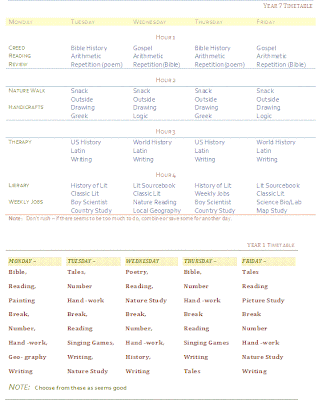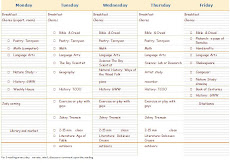 This is what I am looking at when I'm planning out the day. It gives me a basic idea of what we will be doing, in daily and hourly order, so that I know what things to have ready.
This is what I am looking at when I'm planning out the day. It gives me a basic idea of what we will be doing, in daily and hourly order, so that I know what things to have ready.I have been making a binder where I am putting down notes as they occur to me. I mentioned it here, and I finally managed to find a way that sort of works for me... for now, anyway.
I got a fairly big binder -- just a basic binder. I filled it with all these various forms I've been making (they are mostly linked on my sidebar), put in plastic page protectors.
Then I put in dividers -- five of them for now, one for each day of the week.
Behind each divider are several pieces of simple notebook paper. We always have way too much notebook paper around -- I went to some of the Target back to school sales and ended up with enough extra supplies that I didn't even bother to hit the sales the last couple of years. So I have enough paper, I just have a natural Scottish tightwaddish tendency that I have to fight -- that a paper should be filled and then some before you start on a new sheet.
Getting past my Caledonian frugality, on each piece of notebook paper I put the title of one lesson. For example, if you look at the timetable on the left (click to make the gif bigger) -- for Monday there is Creed (abbreviation of Creed in Slow Motion), then Reading, Review, Therapy, Handicrafts, etc. For Year 1 there is Bible, Reading, Painting, etc. So I put a piece of paper for each of these headings, and then scribbled down notes, basically anything that occurred to me but mostly in these categories:
- Materials to Gather
- Connections (ideas for combining subjects, or combining the age levels)
- Further Resources
- Ideas, Notes, Thoughts to Ponder
- Possible problems
- Plan B -- alternative approach
So I thought that by having a physical place for each lesson -- ie, a piece of paper -- I could keep things in order in my head. I always liked the Avilian system I linked to last time (more here and here) with all the workbook pages behind dividers -- but we aren't really using very many workbooks at all. So this page-per-lesson system is sort of a substitute, with the same physicality. When my kids did more workbooks, I used to just pile them up beside the child and that was how they knew what they had to do that day. It "worked" in that they knew what to do, and it worked in that they did learn the basics, but I want to try it a bit differently this year.
I should add, if you do look at the Avilian system, that we are not quite as impressive or structured as Andrea is. For one thing, I have a crew of boys, and 2 of the three next year won't be able to write, or not very much. And they don't like to decorate notebooks; they'd rather do messy science projects and draw dragons and soldiers. And they are not very close in age, so we don't do much multi-level stuff. It's the logistical part of the system that I like.
One more thing -- in the past all these "systems" have fizzled out within three weeks. Once upon a time I felt guilty about this. I finally figured out (D'OH!) that I don't NEED complicated systems once I have the thing internalized. What a breakthrough! Yet, I DO need them very much until I train myself to follow the routine. So, if you have some type of lapse you've been berating yourself for, perhaps it's not a lapse at all. It's worth considering, anyway.
Now back to the piece of paper for every lesson -- I'm trying to get the first week down now, and see approximately how long it takes. Then I can estimate from there how long it will take me to plan every week. Part of my planning is always going to be a Plan B and C. Plan B is "go with the flow" where things are going so well for whatever reason -- the kids are playing wonderfully, or a book or experiment is fascinating -- and we just decide to keep going. Plan C is for Crisis -- it's the barebones version of the Plan. The one that the kids can basically do even if I have little to no time -- even, theoretically, if I'm at a hospital in another city. It's happened before.



No comments:
Post a Comment